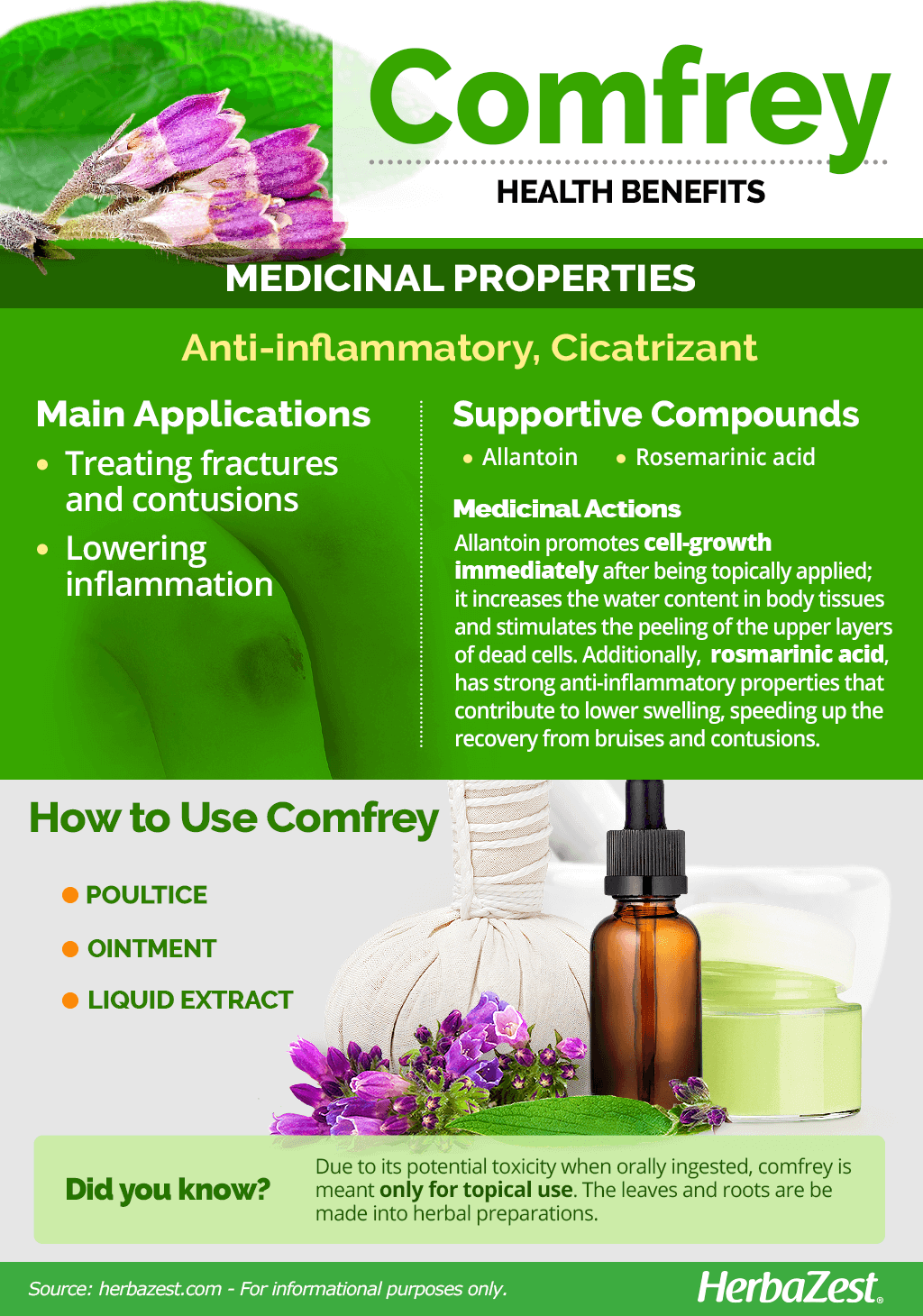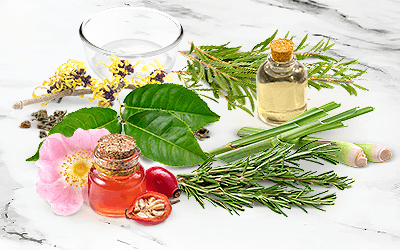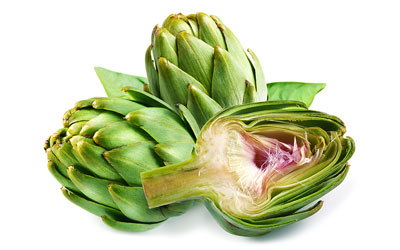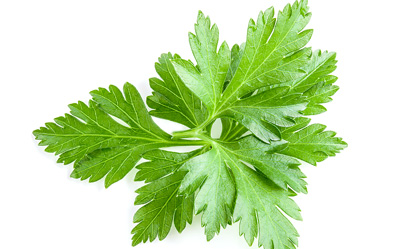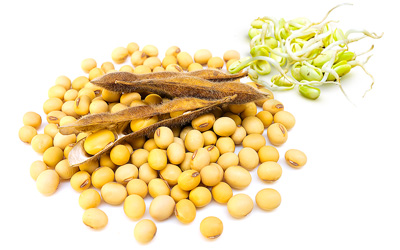One of the original herbal remedies of classical civilizations, comfrey has long been considered both a powerful healing agent and an ornamental beauty. A native to the temperate marshy regions of Europe and Western Asia, comfrey has since been naturalized to similar climates worldwide. It now thrives in North America and Australia with the same strength. Although modern research has altered its uses over the years, today it is still used widely in alternative medicine around the world.
Comfrey Medicinal Properties
- Medicinal action Anti-inflammatory, Cicatrizant
- Key constituents Allantoin, rosmarinic acid
- Medicinal rating (2) Minorly useful plant
- Safety ranking Use with caution
Health Benefits of Comfrey
Although comfrey has been used for a wider range of maladies throughout history, modern research that has been done thus far supports the potential use of topical comfrey preparations for the following purposes:
Treating fractures and contusions. Comfrey is considered effective for healing broken bones and bruises.
Lowering inflammation. Comfrey helps relieve the pain and swelling of contusions and sprains. It has also been shown to be effective reducing the symptoms of osteoarthritis.1
How It Works
Comfrey's primary active compound is allantoin. Allantoin is a very potent cell-growth stimulator and after being applied triggers near-immediate cell proliferation. It increases the water content of the body's organ tissues and stimulates the peeling of the upper layers of dead cells. Comfrey's high levels of rosmarinic acid are responsible for its anti-inflammatory properties and help reduce swelling, accelerating the healing process of bruises and contusions.
The herb also has high concentrations of phenolic acids - notably rosmarinic acid.
Other herbs with wound healing and anti-inflammatory properties are achiote and calendula.
Comfrey Cautions
Comfrey contains highly toxic pyrrolizidine alkaloids, which is why its oral use is unsafe. However, it is still considered relatively safe for topical use when care is taken. In addition, its use in supplements and other ingested products is discouraged worldwide and has been banned in both the U.S. and Canada.
Comfrey should not be given to children or applied to open wounds or broken skin. It should not be used for more than 10 consecutive days, and more no more than four to six weeks out of the year.
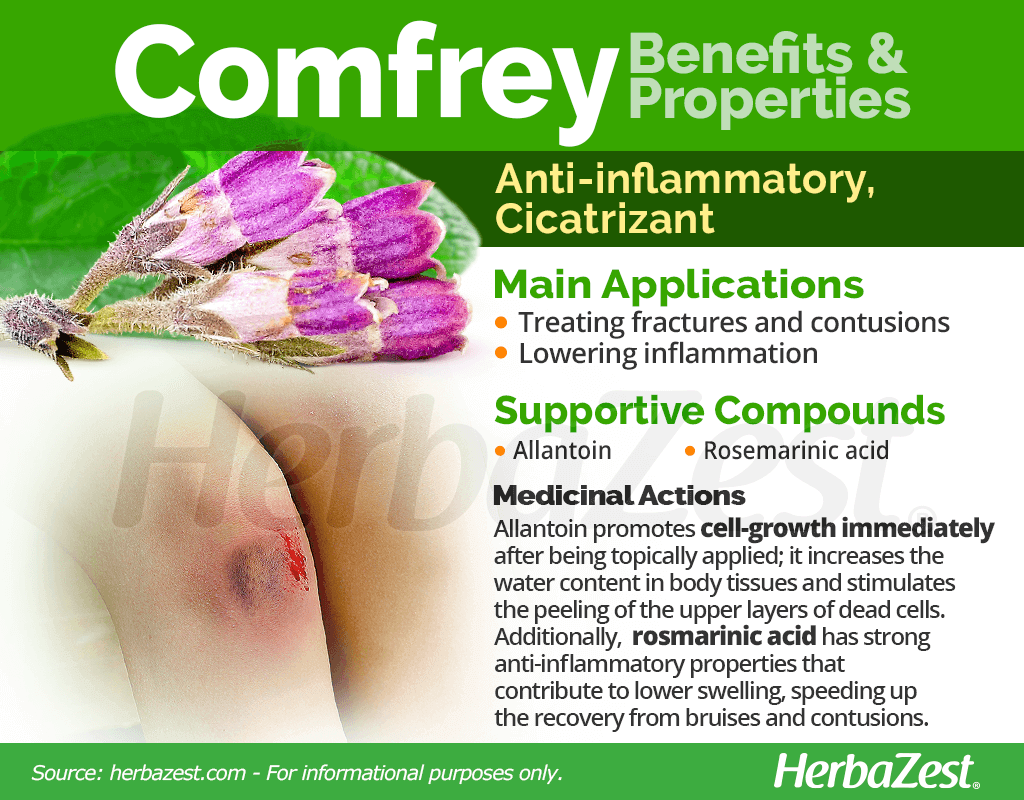
How to Consume Comfrey
Due to its potential toxicity when orally ingested, comfrey is exclusively used topically. The leaves and roots are be made into herbal preparations.
Natural Forms
Poultice. A poultice can be made from one part dried root mashed into 10 parts water. It can be applied to bruises, boils, and closed wounds with a strip of gauze on top.
Herbal Remedies & Supplements
Ointment. Comfrey ointment is typically made from infused oil of comfrey leaves mixed with beeswax. It is spread on bruises. Experts warn to make sure broken bones are set before applying comfrey salve, as bonding will begin almost immediately.
Liquid extract. Product of a distillation process, comfrey extracts can be applied to minor closed wounds and acne.

Growing
- Life cycle Perennial
- Harvested parts Roots, Leaves
- Light requirements Full sun
- Soil Peaty
- Growing habitat Temperate climates
- USDA Plant Hardiness Zones 4a, 4b, 5a, 5b, 6a, 6b, 7a, 7b, 8a, 8b, 9a, 9b
- Plant spacing average 0.1 m (0.30 ft)
- Propagation techniques Root cuttings
A hardy and sturdy perennial, comfrey is a garden favorite for many due to its pleasing, bright flowers and full shape.
Growing Guidelines
It can withstand temperatures as low as -40°F (-40°C), though more temperate climates are ideal.
Deep, fertile soil is best to support its extensive root system - which absorbs large quantities of nutrients - and weeding will help propagation.
- Like many ornamental plants, it prefers full sunlight but will tolerate partial shade.
Comfrey is more commonly grown from root cuttings four to six inches (10 - 15 cm) in length, planted horizontally three inches (7.5 cm) deep and three inches apart.
- Once established, it does not require extensive care, and it is seldom attacked by pests or diseases.
Additional Information
- Other uses Animal feed, Cosmetics
Plant Biology
Growing up to three feet (1 m) tall, its thick leaves and bell-like flowers are arranged on erect stalks that grow together in clusters. Blooms can range in color from white to pink to a deeper mauve, and the dense root system is sometimes harvested for medicinal use.
Classification
A member of the Boraginaceae, or forget-me-not family, comfrey is classed with 2,000 other species of flowering shrubs, trees, and herbs, most notably borage (Borago officinalis).
Varieties and Subspecies of Comfrey
Symphytum officinale is divided into two distinct subspecies, S. officinale officinale and S. officinale uliginosum. The first subspecies has two main varieties: S. officinale officinale var. variegatum, which can be recognized by its leaves with white margins, and S. officinale officinale var. bocking, a sterile hybrid that doesn't self-seed.
In addition, the seven other members of its genus also use the term as part of their nonscientific names. They are primarily differentiated based on physical characteristics like size and texture: S. ibericum, or dwarf comfrey, is the smallest variety, while S. asperum, or rough comfrey, has notably prickly foliage. Symphytum x uplandicum, or Russian comfrey, is actually a hybrid species that is a cross between S. officinale and S. asperum.
Historical Information
The first empirical evidence of human use of comfrey dates back roughly 2,500 years to the herbalists of ancient Greece and Rome. Through the Middle Ages, comfrey was deemed to be effective in treating everything from stomach ulcers to bronchitis, and Catholic monks frequently grew it in their gardens. The herb was brought to England for ornamental use at the turn of the 17th century, from where it traveled to different British Imperial colonies and territories before spreading across the world.
Economic Data
Because recent research has suggested that comfrey should not be ingested, the importance of comfrey as a commercial crop has greatly diminished in recent years. Among certain areas of its largest markets, most notably Canada, the sale of all comfrey supplements and topical preparations was banned altogether, producing a significant toll on the industry. However, the plant remains popular as an ornamental plant and is greatly demanded in England for this purpose. Salves and other skin ointments that feature the herb, however, are still regarded as safe by a significant number of herbalists for treating osteoarthritis, a condition affecting more than 20 million people in the U.S. alone.
Popular Beliefs
In the Christian tradition, some believe comfrey to be one of the patriarchal herbs, present in the Garden of Eden alongside the first of humankind.
Other Uses
Ornamental. Comfrey is viewed as aesthetically beautiful for its shape and colorful blooms in many parts of the world, and thus it is commonly used as an ornamental plant in gardens.
Fodder. It is also sometimes used as animal fodder, as it appears not to affect livestock in the same way as humans.
Cosmetics. Reportedly beneficial for diminishing scars and varicose veins, some beauty products also feature the herb as an ingredient.
Sources
- Government of Canada, Alberta Agriculture and Rural Development: Common Comfrey
- Public Health Nutrition, The Efficacy and Safety of Comfrey, 2000
- Backyard Medicine, pp. 38-41
- USDA Plants Database, Symphytum officinale
- Encyclopedia of Herbal Medicine, p. 137
- American Cancer Society, Comfrey
- Medicinal Plants of the World, p. 314
- New York University - Langone Medical Center, Comfrey
- University of Maryland Medical Center, Osteoarthritis | Comfrey
Footnotes
- Phytomedicine. 2007. Efficacy of a comfrey root (Symphyti offic. radix) extract ointment in the treatment of patients with painful osteoarthritis of the knee: results of a double-blind, randomised, bicenter, placebo-controlled trial. Retrieved April 02, 2020, from https://www.sciencedirect.com/science/article/abs/pii/S0944711306001759
